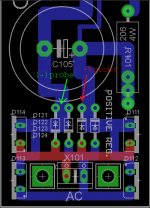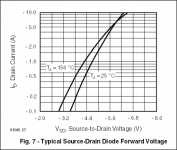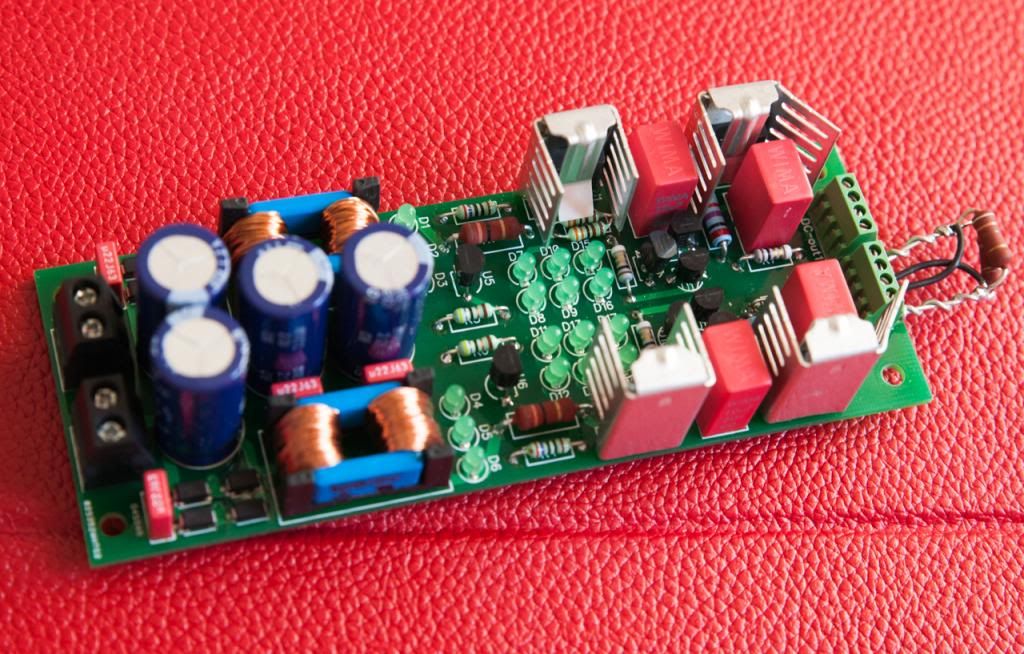The sinking must be good for the CCS MOSFET at those currents also. Maybe an IRF9530 in place of the IRF9610 if the situation is too hot for given sinking at 1-1.2A setting. Looks like starving and TC shifting now. Circa 0.75R looks more appropriate to use now either as a single R101 or by piggyback of a 3.3R on the 1R. Check for possible ducking of input voltage while at work also. You can measure the rectified DC there:
Attachments
See this graph attached. Its the 9610's ID/VSD curves. If you want it pass ~1A it will need ~4.7VSD to maintain it. You got to add the R101 setting resistor's drop to that up to VinDC. If your Vin-Vout does not give you that margin it will start dropping from a lower draw. That is what Andrew wrote about too.
Attachments
My methodology is to leave the load resistor in place, assuming enough 'free' current, and jumper to the device itself, see if it powers up appropriately.
I've lost a few volts in one project, and it was oscillating. It did not drop as much as yours by percentage. if you have a scope you could try that.
Thanks I will give that a go. I think also the responses to the next posted question might also apply to me. Im using the standard 15v 30va toroid from tpa, which might not have enough..
Here is how my 2x SSLV-positive smaller pcb's turned out. Will use them two pcb's to feed the Sen I/V
Very nice job!
Could you give more details about it?- Doesn´t need the SEN a floating power supply for each phase?Here is how my 2x SSLV-positive smaller pcb's turned out. Will use them two pcb's to feed the Sen I/V
Could you give more details about it?- Doesn´t need the SEN a floating power supply for each phase?
Well, the SSLV is floating, as long as you don't give it any connection to mains earth. It's exactly the same as batteries - they are also floating as long as you don't connect the negative to mains earth.
PCB-size 127x47mm with common mode choke between the two first caps. Only problem with this small boards is that caps only 2x1500uf (for 35v at least) and not big room for the current-set resistor. I made the boards for low-current usage, and because of that i only made room for 3x current set-leds also.
Thanks Salas
I increased the input to 13.5 and the output keep stable at 5.25V up to more than 1.5A.
Of course.

Well, the SSLV is floating, as long as you don't give it any connection to mains earth. It's exactly the same as batteries - they are also floating as long as you don't connect the negative to mains earth.
PCB-size 127x47mm with common mode choke between the two first caps. Only problem with this small boards is that caps only 2x1500uf (for 35v at least) and not big room for the current-set resistor. I made the boards for low-current usage, and because of that i only made room for 3x current set-leds also.
not strictly true, batteries dont even have a parasitic connection to mains earth, or any mains related ripple or noise at all. they have their own noise components from the chemical reaction and noise pickup on the leads but thats it.
Last edited:
Ok, maybe not exactly as batteries, that was a bad example - but the supply is still floating if you don't connect it to mains earth. Then there is of course other negative stuff with a transformer such as interwinding capacitance and noise that makes it through the net. But the thing is that alot of people doesn't seem to understand that transformers are usually floating if you don't give them connection to mains earth.
that would be the main parasitic connection I was talking aboutThen there is of course other negative stuff with a transformer such as interwinding capacitance and noise that makes it through the net.
a parasitic is simply an unwanted (usually) additional effect other than those desired ones you are cultivating. here its mostly cap allowing other effects to couple through the transformer
Last edited:
- Home
- Amplifiers
- Power Supplies
- SSLV1.1 builds & fairy tales


